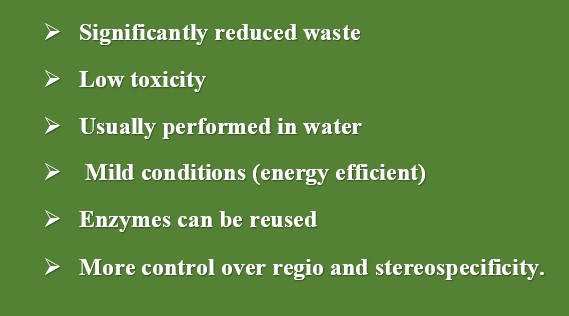



In the mid-1980s, there was a significant public concern on the huge amount of chemical waste generated by chemical and pharmaceutical industries. A paradigm shift was clearly needed from this traditional approach by the chemical industry with respect to the generation of hazardous and toxic waste. There was an immediate focus on cleaner chemistry, resource efficiency and bio-processes to produce less waste. This, alternative route, came to known as “Green Chemistry”.
The industrial process of synthesizing different compounds largely depends on chemical catalysis where mostly heavy metals are used as a catalytic agent. Metals like rhodium, palladium, ruthenium are often used as a catalyst for asymmetric transformation in the synthesis routes. However, such metals are scarce in nature and the cost of mining these metals makes the overall process more expensive. The urge for the most cost-effective as well as cleaner methods for industrial synthesis of enantiomeric pure drugs opens another gateway where enzymes are used instead of heavy metals.
The idea of using enzymes in chemical synthesis began in 1948 when Linus Pauling wrote in a Nature paper that “I think the enzymes are molecules that are complementary in structure to the activated complexes of the reactions that they catalyze.” In early 1950s limited knowledge was available about the enzymes. However, the situation dramatically changed in the last few decades, thanks to the advances in biotechnology. With increasing number of crystal structures solved, the idea about the three-dimensional structure of proteins and enzymes have become more concrete
Now, to keep up the pace with that paradigm shift, computational methods are used to engineer the enzymes that targeted the activity, specificity, and stability. “QZyme WorkBenchᵀᴹ”, is such a computer-based protocol designed by Quantumzyme which is used to engineer the enzyme for the desired activity or specificity. Currently, a target gene can be identified in silico by “genome mining” with the help of genome sequence database.
With the sequencing of a large number of microbial genomes, and the availability of this information in the public domain, it is now possible to readily synthesize a broad range of enzymes.
Hence, biocatalysts evolved into an industrially attractive technology that is now well integrated into to the mainstream organic synthesis. Finally, we summarize the advantages of biocatalyst as compared to the traditional chemical catalyst.
We can say that industrial biocatalyst has come a long way in the past two decades and it is going to be the driving force for many areas such as pharmaceutical, food and beverage industries. A definite paradigm shift has happened from the traditional chemical approaches.